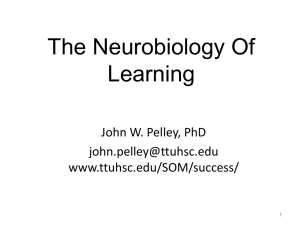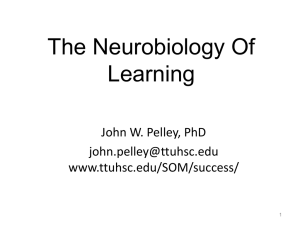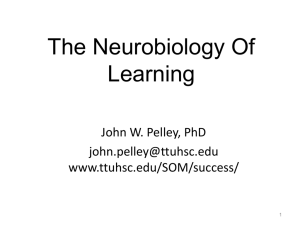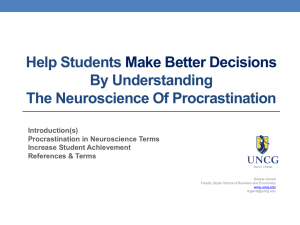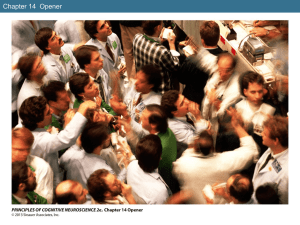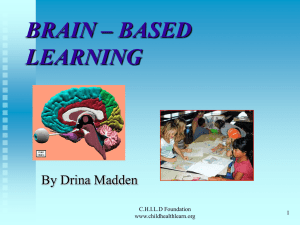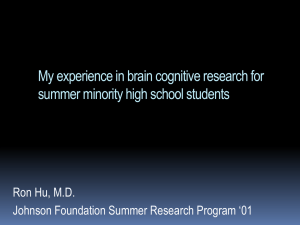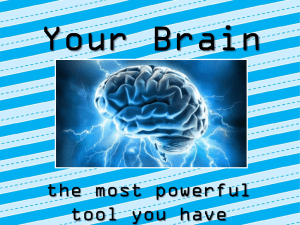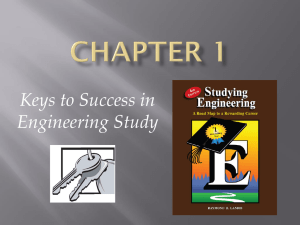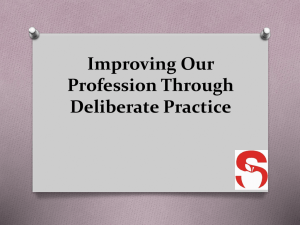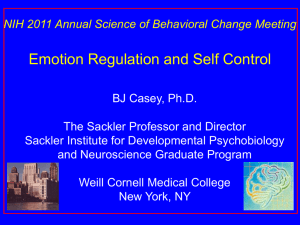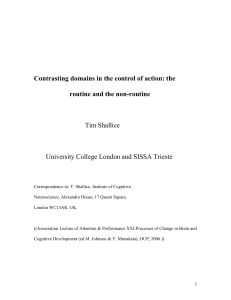Growth Mindset
advertisement
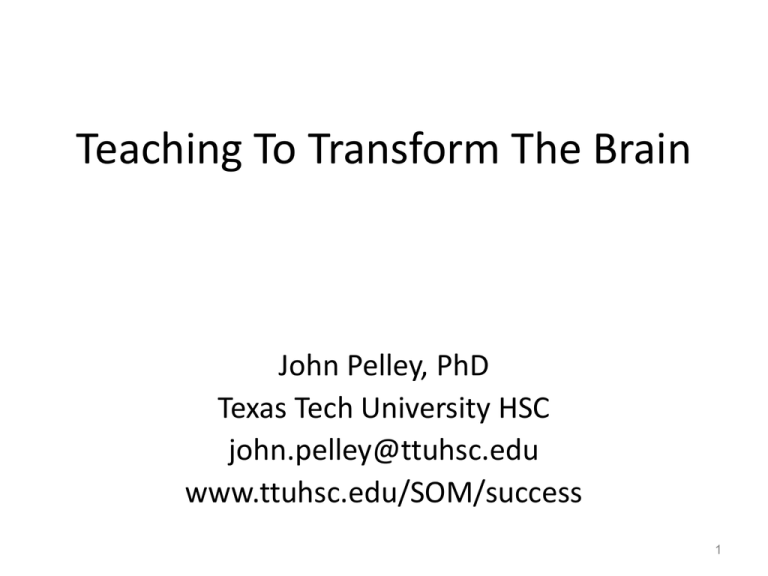
Teaching To Transform The Brain John Pelley, PhD Texas Tech University HSC john.pelley@ttuhsc.edu www.ttuhsc.edu/SOM/success 1 Learning – Whose Job Is It Anyway? “The purpose of an educational institution is to lead the students, who initially believe the educational institution is there to educate them, to the realization that they must educate themselves.” “They must …learn how to learn [integratively]…” From Willis Hurst, MD, Medscape [and Pelley] 2 Main Points Today 1. Students need to transform their brains from receiver role to producer role. – Receiving information vs producing knowledge 2. Deliberate Practice (DP) produces expert learning skills. – – Growth Mindset requires Deliberate Practice. Responsibility for learning lies with student. 3. Brain research clarifies thinking/learning “styles.” – Learning style provides insight for DP use in developing expert learning skills 3 Why Is It Important To Know How The Brain Works? • Required for “Growth Mindset” – Increases intelligence • Permits “Deliberate Practice” – Increases expert skill acquisition 4 Growth vs Fixed Mindset Growth Mindset – “Feel smart when you are learning.” • “You can always change how intelligent you are.” Fixed Mindset – “Feel smart when you are flawless.” • “You have a certain amount of intelligence and you can’t change it.” 5 Mindset Comparison Fixed Mindset • Success based on innate ability • Failure is dreaded, feared. – Reveals limited intelligence • Least likely to succeed Growth Mindset • Success based on focused effort • Failure is a challenge. – Apply Deliberate Practice • Most likely to succeed 6 Growth Mindset Through Deliberate Practice • Designed specifically to improve performance – Only perfect practice makes perfect. – Deliberate Practice is perfect practice. • Deliberate Practice: Practice correcting weaknesses/limitations. – Requires self-awareness … and self-acceptance. – Teachers provide feedback and support! • Need to avoid automated behavior – Loss of focus and attention, esp. while reading 7 Learning How The Brain Learns • Thalamus • Base of brain • Distributes sensory input to higher centers • Thinking requires both input and memory • How you do your best thinking: - Talk it out first or, - Think it through first, then talk 8 Low Gain vs. High Gain • Talk it out – “low gain” thalamic activity; seeking more input; more active – Extraversion; low arousal level – too quiet – Lower cerebral blood flow, augmentation of “evoked response,” lower doses of sedatives • Think it through – “high gain” thalamic activity; reducing input; more reclusive – Introversion; high arousal level – too loud – Higher cerebral blood flow, reduction of “evoked response,” higher doses of sedatives 9 What Is Jungian Personality? • Consistent, unconscious behavior – Can be consciously overridden • The way we think (psychology) • The way we are wired (anatomy/physiology) What Is Jungian Personality - Not? • Limitation – only a preference • Stereotype – all types have positive description • Intelligence – Insight into thinking only 10 Is Learning A Skill? We will now consider each of the following: 1. Learning style as a preference, not a limitation 2. Learning style as a preference for a specific step in experiential learning 3. Experiential learning as critical thinking 4. Critical thinking as whole brain learning 5. Whole brain learning as a set of skills 11 Myers-Briggs (Jungian) Personality Types As A “Learning Style” • Mental model for thinking process • “Type” influences how you learn • Affects academic performance 12 13 Myers-Briggs Personality Types • Mental Model: Extraversion (E) vs. Introversion (I)* Sensing (S) vs. Intuition (N)* Thinking (T)* vs. Feeling (F) Judging (J) vs. Perceiving (P)* *Pelley’s type • Normal differences between people • Persistent tendencies (choices) – Do not change once established – e.g. Folding your arms, throwing a ball, writing your name • Comfort zone for thinking; requires less effort than the opposite – Use of opposite is a conscious effort 14 Sensing (S) vs. Intuition (N) • What information do you give the most attention to? • Sensing types give their attention to specifics • Intuitive types give their attention to the big picture • Everyone does both, but only one is preferred. – Use of opposite is deliberate; not automatic 15 Test Taking Style • S style – Seek answer that matches memorized knowledge – Re-read question to stimulate recall – Memorization learning requires recognition • N style – Rule out answer choices – Don’t fit learned patterns – Big picture learning establishes patterns 16 Problems With Big Pictures Vs Details • Sensing types tend to see a big picture (pattern) as one more fact. • Intuitive types tend to see only enough facts to make a big picture. 17 Memorization vs HOTS Type Differences • Memorization – Recall: remembering facts/details and their “organization” (list the symptoms of heart attack) – Preferred by sensing types • Higher Order Thinking Skills (HOTS) – Grouping: “organizing” facts into patterns – Comparing: relationships between patterns (list the causes of chest pain) – Preferred by intuitive types 18 Transforming The Brain • What does brain anatomy tell us about how we learn? • How do we change our brains? 19 Experiential Learning Cycle Achieving Long Term Potentiation Outside Can it be used? [Act] Concrete experience Testing implications of concepts in new situations (Kolb, 19 84 , p .21 ) Experience new information [Sense] Observations and reflections What is it? [Recognize] What does it mean? [Integrate] Formation of abstract concepts and generalizations Inside 20 Experiential Learning By The Brain Some Motor Skills Thinking Skills Sensory Skills Memory Skills Adapted from Zull, 2002, The Art of Changing the Brain 21 Receiving Information vs. Production Of Knowledge 1. Concrete experience; sensory cortex organizes information 2. Reflective observation; temporal cortex recognizes information 3. Abstract conceptualization; pre-frontal cortex evaluates and decides 4. Active testing; motor cortex acts on information – produces knowledge from the outcome. 22 Prefrontal Pause • How is recognition different from recall? • Related question: What area of the brain is responsible for each? 23 Which Areas Of The Brain Process Each Of The Following? 1. Recall – Define hyperglycemia, ketoacidosis, glycosylation. (Temporal) 2. Analysis – Give the characteristics of type 1 diabetes. (PreFrontal and Temporal) 3. Comparison – Explain how type 1 and type 2 diabetes are both similar and different. (PF&T) 4. Inference – Justify your diagnosis of type 2 diabetes. (PF&T) 5. Evaluation – Develop a treatment plan for a type 2 diabetic. (PF&T) 24 If You Build It (Frontal Skills), They Will Come (Temporal Skills). • Back (temporal cortex) = fact memory • Front (prefrontal cortex) = analytic (decision making) skill memory • If you develop analytical skills, longterm memory will follow. • Design instruction to use the “front.” 25 Developing Expert Skills – Physically Transforming The Brain • How do we change our brains? • Learning efficiency: What is the “illusion of memory?” • What does brain anatomy tell us about how we learn? • Clinical skill areas of the brain 26 How Does Experience Make The Brain Grow? • Decisions produce motor activity • Motor activity becomes new concrete experience. • Experience associated with emotion • Anatomical changes at synaptic connections during sleep 27 Phosphorylation – The Illusion Of Memory • The brain is designed to forget. • Phosphorylation is the mechanism. • Protein synthesis is the override. 28 Forgetting Can Be A Good Thing • New information input → signal at the neuronal synapse • Two things can happen: 1. No further use of the information → decay of the signal → neuron “forgets” 2. Continued use of the information → sustained signal → synthesis of new proteins → neuron “remembers” • Rehearsal by hippocampus during sleep (5 REM cycles, 7.5 hrs, minimum) 29 What Happens If Active Testing Is Not Done? • The brain protects itself by forgetting 30 Can You Find The Sittin’ And Readin’ Dendritic Tree? Sittin’ and readin’ 1. Complete learning cycle 2. Sleep (5 REM cycles) Control left, long-term potentiated (LTP) cells sensitized right Tree of LTP markedly increased (hippocampus “rehearsal”). Dendritic trees are “processing power.” Prefrontal dendritic growth increases analytic skill. 31 Short Circuiting The Learning Cycle • Continuous sensory input into temporal lobes, i.e. “sitting and reading” • Minimal motor activity – Prevents dendritic growth – Ensures memory loss • Illusion of learning – Phosphorylation signal decays – Failure of dendrite growth 32 What Type Of Teaching Strategies Help To Produce Complete Learning Cycles? • Prefrontal pauses • Two-level Concept Maps • Case Vignette Question Analysis 33 Prefrontal Pause • Students turn to a neighbor and discuss a HOTS question. – 1-2 minutes – Related to content just taught – Usually short essay; can be MCQ • Requires use of prefrontal area • Emphasis is always on giving a rationale – It’s that way in the notes isn’t a rationale • Audience response (“clicker”) exercises should always be open book with discussion. 34 Question analysis • Each answer choice is studied in depth to establish conditions that rule out or accept • Understanding the correct answer. – Minimum knowledge to rule-in the correct answer • Understanding the wrong answers. – Minimum knowledge to rule-out the wrong answers – Rephrasing the question • Check SuccessTypes book at website 35 36 Concept Mapping and DP • One of the following will be harder to do than the others 1. Focus and attention (sensory/temporal/prefrontal) 2. Identifying the grouping terms (prefrontal/temporal) 3. Identifying subtopics (prefrontal/temporal) 4. Organizing relationships at each level of complexity (prefrontal/temporal) 5. Drawing the map (prefrontal/motor) 37 38 DP Outcomes From Concept Mapping • Slow at first as most-limiting brain function undergoes development – Limiting function is identified and practiced • Faster processing during consolidation of skill areas – Capacity to make decisions faster – Capacity to access long term memory faster • Capacity to retain fact (declarative) memory increased • Transfer of skill to other problem solving venues 39 Easiest Route To Change/Influence • Communicate “through” type of learner – Be specific with sensing types – Be visionary with intuitive types • Expect adaptation and learning – Type is a starting line not a finish line – Type is not an excuse or a “cause” – Balanced use of type characteristics is mark of skill development 40 Recap • • • • • Experiential learning “flows” through the cortex – Always completed through action – Personality type reflects time allocation. The brain is a work in progress. Experiential learning develops both: 1. Cognitive memory 2. Critical thinking skills Long-term memory is external evidence of dendritic tree growth (temporal cortex). Critical thinking (analytic) skill is external evidence of dendritic tree growth (prefrontal cortex). 41 Key References Mindset: The New Psychology of Success, Dweck, C., 2006. K. Anders Ericsson, “Deliberate Practice and the Acquisition and Maintenance of Expert Performance in Medicine and Related Domains.” Academic Medicine, 2004;79:October Suppl.70-S81. Measuring Thinking Skills in the Classroom, Revised Edition, Stiggins, R., Rubel, E. and Quellmalz, E., 1988. National Education Association, (also use internet search) The Art Of Changing The Brain. Zull, J. 2002. Sterling, VA: Stylus Publishing, LLC. How People Learn: Brain, Mind, Experience, and School. Bransford, J. D., Brown, A. L. & Cocking, R. R. (Eds.). 2000. Washington, DC: National Academy Press. (free download from NAP website) SuccessTypes Medical Education Website: Expert Skills Program Link, www.ttuhsc.edu/som/success/esp.aspx 42
